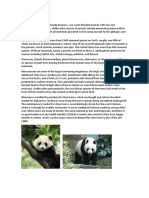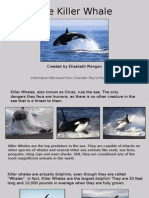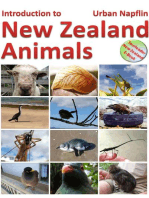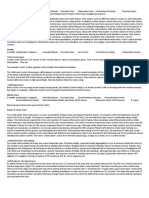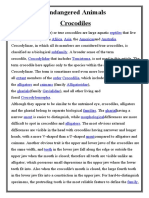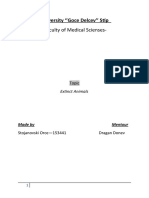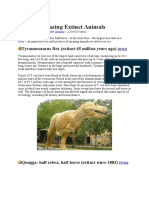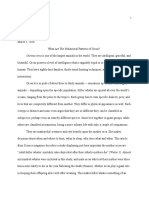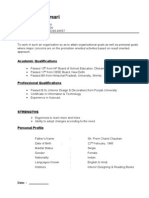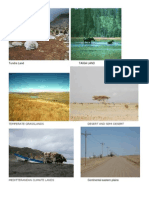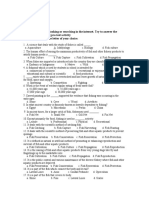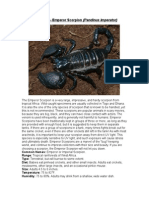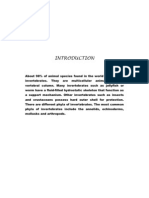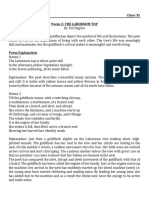North American Porcupine Porc-Épic D'amérique Du Nord Puerco Espín
North American Porcupine Porc-Épic D'amérique Du Nord Puerco Espín
Uploaded by
itsankurzCopyright:
Available Formats
North American Porcupine Porc-Épic D'amérique Du Nord Puerco Espín
North American Porcupine Porc-Épic D'amérique Du Nord Puerco Espín
Uploaded by
itsankurzOriginal Description:
Original Title
Copyright
Available Formats
Share this document
Did you find this document useful?
Is this content inappropriate?
Copyright:
Available Formats
North American Porcupine Porc-Épic D'amérique Du Nord Puerco Espín
North American Porcupine Porc-Épic D'amérique Du Nord Puerco Espín
Uploaded by
itsankurzCopyright:
Available Formats
Erethizontidae North American Porcupine Porc-pic d'Amrique du nord Puerco espn
Porcupines are rodents with a coat of sharp spines, or quills, that defend them from predators. They are endemic in both the Old World and the New World. After the capybara and the beaver, Porcupines are the third largest of the rodents. Most porcupines are about 2536 in (630910 mm) long, with an 810 in (200250 mm) long tail. Weighing between 1235 lb (5.416 kg), they are rounded, large and slow. Porcupines come in various shades of brown, grey, and the unusual white. A porcupine is any of 27 species of rodent belonging to the families Erethizontidae or Hystricidae. All defend themselves with hair modified into sharp spines. Porcupines vary in size considerably: Rothschild's Porcupine of South America weighs less than a kilogram (2.2 lb (1.00 kg)); the African Porcupine can grow to well over 20 kg (44 lb). The two families of porcupines are quite different and although both belong to the Hystricognathi branch of the vast order Rodentia, they are not closely related. The eleven Old World porcupines are almost exclusively terrestrial, tend to be fairly large, and have quills that are grouped in clusters. They are believed to have separated from the other hystricognaths about 30 million years ago, much earlier than the New World porcupines. The twelve New World porcupines are mostly smaller (although the North American Porcupine reaches about 85 cm/33 in in length and 18 kg/40 lb), have their quills attached singly rather than grouped in clusters, and are excellent climbers, spending much of their time in trees. The New World porcupines evolved their spines independently (through convergent evolution) and are more closely related to several other families of rodent than they are to the Old World porcupines. Porcupines' quills or spines take on various forms, depending on the species, but all are modified hairs coated with thick plates of keratin, and they are embedded in the skin musculature. Old World porcupines (Hystricidae) have quills embedded in clusters, whereas in New World porcupines (Erethizontidae) single quills are interspersed with bristles, underfur, and hair. Porcupine quills are as sharp as needles, detach very easily, and will remain embedded in an attacker. Unlike needles, however, the quills of New World porcupines have microscopic, backwards-facing barbs on the tip that catch on the skin making them difficult and painful to extract, though they must be removed. Quills are about 75 millimetres (3.0 in) long and 2 millimetres (0.079 in) wide. If a quill becomes lodged in the tissues of a would-be attacker, the barbs act to pull the quill further into the tissues with the normal muscle movements of the attacker, moving up to several millimeters in a day. Predators have been known to die as a result of quill penetration and infection. Quills are still capable of penetrating animals and humans even after death. Quills are released by contact with them or they may drop out when the porcupine shakes them, they are not sprayed out.
Beaver
Castor
Beavers are two primarily nocturnal, semi-aquatic species of rodent, one native to North America and one to Europe. They are known for building dams, canals, and lodges (homes). They are the second-largest rodent in the world (after the capybara). Their colonies create one or more dams to provide still, deep water to protect against predators, and to float food and building material. The North American population was 60-400 million, but as of 1988, 6-12 million, due to being hunted for fur, for their glands used as medicine and perfume, and because their harvesting of trees and flooding of waterways may interfere with other land uses. Beavers are known for their natural trait of building dams in rivers and streams, and building their homes (known as beaver lodges) in the resulting pond. Beavers also build canals to float build materials that are difficult to haul over land. They use powerful front teeth to cut trees and plants that they use for building and for food. They are known for their "danger signal": when startled or frightened, a swimming beaver will rapidly dive while forcefully slapping the water with its broad tail. This creates a loud "slap", audible over large distances above and below water. This noise serves as a warning to beavers in the area. Once a beaver has made this danger signal, nearby beavers dive and may not reemerge for some time. Beavers are slow on land, but good swimmers that can stay under water for as long as 15 minutes. (Wilson, 1971) Rarely, a frightened beaver attacks a human.
Beavers do not hybernate, but store sticks and logs underwater to feed on during the winter. Fossil remains of beavers are found in the peat and other superficial deposits of England and the continent of Europe; while in the Pleistocene formations of England and Siberia occur remains of a giant extinct beaver, Trogontherium cuvieri, representing a genus by itself. Beavers have webbed hind-feet, and a broad, scaly tail. They have poor eyesight, but keen senses of hearing, smell, and touch. Beavers continue to grow throughout life. Adult specimens weighing over 25 kg (55 lb) are not uncommon. Females are as large as or larger than males of the same age, which is uncommon among mammals. They are the only extant members of the family Castoridae, which contains a single genus, Castor. Genetic research has shown the European and North American beaver populations to be distinct species and that hybridization is unlikely. Beavers are closely related to squirrels (Sciuridae), agreeing in certain structural peculiarities of the lower jaw and skull. In the Sciuridae the two main bones (tibia and fibula) of the lower half of the leg are quite separate, the tail is round and hairy, and the habitats are arboreal and terrestrial. In the beavers or Castoridae these bones are in close contact at their lower ends, the tail is depressed, expanded and scaly, and their habitats are aquatic. European and American beavers grow to about 2 ft (0.61 m) long (plus 10 in (250 mm) of tail). They are essentially aquatic in their habits, never traveling by land unless driven by necessity. They are crepuscular rather than nocturnal, which means they are active at dawn and dusk, and subsist chiefly on bark and twigs or the roots of water plants. They have been known to eat grasses on the banks of rivers and streams.
Kangaroo
Kangourou
Canguro
A kangaroo is a marsupial from the family Macropodidae. In common use the term is used to describe the largest species from this family, the Red Kangaroo, the Antilopine Kangaroo, and the Eastern and Western Grey Kangaroo of the Macropus genus. The family also includes many smaller species which include the wallabies, tree-kangaroos, wallaroos, pademelons and the Quokka, some 63 living species in all. Kangaroos are endemic to the continent of Australia, while the smaller macropods are found in Australia and New Guinea. In general, larger kangaroos have adapted much better to changes wrought to the Australian landscape by humans and though many of their smaller cousins are endangered, they are plentiful. They are not farmed to any extent, but wild kangaroos are shot for meat, sport, and to protect grazing land for sheep and cattle. Although there is some controversy, harvesting kangaroos for meat has many environmental and health benefits over sheep or cows grazed for meat. The kangaroo is an Australian icon: it is featured on the Australian coat of arms, on some of its currency, and is used by many Australian organisations, including Qantas. Europeans have long regarded kangaroos as strange animals. Early explorers described them as creatures that had heads like deer (without antlers), stood upright like men, and hopped like frogs. Combined with the two-headed appearance of a mother kangaroo, this led many back home to dismiss them as travellers' tales for quite some time. The first kangaroo to be exhibited in the western world was an example shot by John Gore, an officer on Captain Cook's Endeavour in 1770. The animal was shot and its skin and skull transported back to England whereupon it was stuffed, by taxidermists who had never seen the animal before and displayed to the general public as a curiosity. Kangaroos have large, powerful hind legs, large feet adapted for leaping, a long muscular tail for balance, and a small head. Like all marsupials, female kangaroos have a pouch called a marsupium in which joeys complete postnatal development. Kangaroos have few natural predators. The Thylacine, considered by palaeontologists to have once been a major natural predator of the kangaroo, is now extinct. Other extinct predators included the Marsupial Lion, Megalania and the Wonambi. However, with the arrival of humans in Australia at least 50,000 years ago and the introduction of the dingo about 5,000 years ago, kangaroos have had to adapt. The mere barking of a dog can set a full grown male boomer into a wild frenzy. Wedge tailed Eagles and other raptors usually eat
kangaroo carrion. Goannas and other carnivorous reptiles also pose a danger to smaller kangaroo species when other food sources are lacking. Along with dingos and other canids, introduced species like foxes and feral cats also pose a threat to kangaroo populations. Kangaroos and wallabies are adept swimmers, and often flee into waterways if presented with the option. If pursued into the water, a large kangaroo may use its forepaws to hold the predator underwater so as to drown it. Another defensive tactic described by witnesses is catching the attacking dog with the forepaws and disembowelling it with the hind legs.
Striped dolphin
Striped dolphin Order : Cetacea Suborder : Odontoceti Family : Delphinidae Species : Stenella coeruleoalba
The Striped Dolphin (Stenella coeruleoalba) is an extensively studied animal. It lives in all the world's oceans, preferring the temperate and tropical waters (preferring 18-22 degrees celius, although they are spotted in waters ranging from 10 - 26 degrees celsius). They can reach lengths of up to 2.6 metres and can weigh around 160 kg and can reach 60 years of age.They travel in groups of more than 100 individuals, feeding on small fish and squid. Although numerous attempts, these dolphins cannot be kept in captivity, because of refusing to be fed. The total population is estimated to exceed two million individuals. The Euphrosyne dolphin, striped dolphin is listed as Conservation Dependent (LR/cd), the focus of a continuing taxon-specific or habitat-specific conservation programme targeted towards the taxon in question, the cessation of which would result in the taxon qualifying for one of the threatened categories below within a period of five years, on the IUCN Red List of Threatened Species
Namings for the striped dolphin
A young / baby of a striped dolphin is called a 'calf or pup'. The females are called 'cow' and males 'bull'. A striped dolphin group is called a 'team, school, pod, herd, alliance (male) or party (female)'.
Peale's dolphin
Picture has been licensed under a GFDL Original source: Transferred from en.wikipedia; Transfer was stated to be made by User:PurpleHz. (Original text : self-made) Author: Original uploader was FDrummondH at en.wikipedia (Original text : Frank Holden) Permission: GNU Free Documentation License
Peale's dolphin Order : Cetacea Suborder : Odontoceti
Family : Delphinidae Species : Lagenorhynchus australis
The Blackchin dolphin, peale's dolphin is listed as Data Deficient (DD), inadequate information to make a direct, or indirect, assessment of its risk of extinction, on the IUCN Red List of Threatened Species
Namings for the Peale
A young / baby of a Peale is called a 'calf or pup'. The females are called 'cow' and males 'bull'. A Peale group is called a 'team, school, pod, herd, alliance (male) or party (female)'.
Countries
Argentina, Chile and Falkland Islands (Islas Malvinas)
Habitats
Epipelagic (0-200m), Macroalgal / Kelp, Marine Neritic, Marine Oceanic and Pelagic
Facts about the Peale's dolphin
Description & Fascinating FactsPeale's dolphin, Lagenorhynchus australis, is small cetacean with a stocky body and a very small beak. (Full text) Blackchin Dolphin or Lagenorhynchus australis is listed on the IUCN Red list (1996) as Data Deficient . (Full text) The Peale's Dolphin (Lagenorhynchus australis) is a robust and large dolphin. For example, Peale's dolphin (Lagenorhynchus australis) is native to cold waters of the Atlantic and Pacific off the southern part of South America. Physical description Peale's Dolphin is of typical size in its family - about 1m in length at birth and 2. (Full text) Peale's Dolphin is of typical size in its family - about 1m in length at birth and 2. (Full text) Lifespan-- The Peale's dolphin is dark grey or black. (Full text) The Peale's dolphin is known to ride the bow waves of large vessels and may swim alongside smaller ones. (Full text) 4 Conservation 5 References Physical description Peale's Dolphin is of typical size in its family about 1m in length at birth and 2. Peale's dolphin is native to cold waters of the Atlantic and Pacific off the southern part of South America. (Full text) Recognition at sea: Peale's Dolphins are most likely to be confused with the similar Dusky Dolphin. Recognition at Sea: Peale's dolphins are most likely to be confused with the similar Dusky dolphin. (Full text) Peale's dolphins are grayish black above and white below. (Full text) Adult Peale's dolphins are dark gray to black in color with lighter shading on the flanks. (Full text) Peale's dolphins are greyish black above and white below. Biology and Behaviour Habitat: Peale's dolphins are often seen near the coast, and so are easily observed. (Full text) Peales Dolphins are subject to entanglement in gillnets set near shore, but the scale of incidental mortality is not considered large in any area of their range.
Blue whale
Blue whale
Order : Cetacea Suborder : Mysticeti Family : Balaenopteridae Species : Balaenoptera musculus
The blue whale (Balaenoptera musculus) was hunted almost to extinction until hunting was outlawed in 1966, and today humans still disturb these beautiful underwater giants. With the increase of the noise from ships and military sonar, blue whales have a hard time communicating with each other. Read about it on National Geographic. Furthermore, they are threatened by illegal whaling, pollution and fishing nets. The world population is estimated between 3,000 and 4,000 (source). They are considered an endangered species. Yesterday i saw an episode of Genographic Project on National Geographic, about the evolution on whales. According to the Genographic project, all cetaceans descended from a wolf-like creature. But a little search on google shows a lot of different views, including the hippopotamus. Did you know adult blue whales are about the same size as a boeing 737 ?
AMPHIBIANS
Southern Leopard Frog Rana sphenocephala (Rana utricularia)
Family: Ranidae, True Frogs view all from this family Description 2-5" (5.1-12.7 cm). Slender and narrow-headed; green to brown, with large dark spots between light-colored dorsolateral ridges - ridges continuous to groin. Light stripe along upper jaw; typically, a light spot in center of eardrum. Subspecies Florida Leopard Frog (R. s. sphenocephala), northern Florida to Florida Keys. Southern Leopard Frog (R. s. utricularia), eastern seaboard from s. New York to c. Texas, north to c. Illinois and Indiana. Some authorities do not recognize the Florida population as a separate subspecies. Voice Series of short throaty croaks. Males call while afloat or from land. Breeding Year-round in southern areas, March to June in northern areas. Egg masses are laid in shallow water. Habitat Any freshwater location. Wanders among moist vegetation in the summer, returns to freshwater ponds and streams and brackish marshes rest of year. Range From s. New York to the Florida Keys, west to Texas and e. Oklahoma, north to ec. Kansas. Discussion The most ubiquitous frog of the eastern states. Primarily nocturnal. During the day, it hides in grass or sedges or sunny banks. To elude a predator - such as a raccoon or waterbird - this frog dives into the water, makes a sharp turn while still submerged, and surfaces amid vegetation at the water's edge; meanwhile the predator continues to search in the direction of the original dive. This is the species most frequently hunted for frogs' legs by youngsters in the Southeast.
American Bullfrog Rana catesbeiana
Family: Ranidae, True Frogs view all from this family Description 3 1/2-8" (9-20.3 cm). The largest frog in North America. Green to yellow above with random mottling of darker gray. Large external eardrum; hind feet fully webbed except for last joint of longest toe. No dorsolateral ridges. Belly cream to white, may be mottled with gray. Voice Deep-pitched jug o'rum call can be heard for more than a quarter mile on quiet mornings. Breeding Northern areas, May to July; southern, February to October. Egg masses are attached to submerged vegetation. Tadpoles are large, 4-6 3/4" (10.2-17.2 cm), olive-green, and may take almost 2 years to transform. Habitat Aquatic. Prefers ponds, lakes, and slow-moving streams large enough to avoid crowding and with sufficient vegetation to provide easy cover. Range Eastern and central United States; also New Brunswick and parts of Nova Scotia. Extensively introduced in the West. Discussion Nocturnal. Less aquatic than the Pig Frog, it is usually found on the bank at water's edge. When frightened, it will as soon flee into nearby vegetation as take to the water. Large specimens have been known to catch and swallow small birds and young snakes; its usual diet includes insects, crayfish, other frogs, and minnows. Attempts to commercially harvest frogs' legs have prompted many introductions of the American Bullfrog outside its natural range.
Southern Toad, Bufo terrestris
The Southern Toad is a medium sized toad reaching lengths around 3 inches or more. This toad can easily be distinguished from other toads in the southeast by the shape of its cranial crests. These form knobs in the area between the eyes (see diagram), and when seen from the right direction they give the impression that the toad has horns. These knobs are not well developed, however, on young specimens. Their coloration varies from brick red to brown or light gray. Sometimes there is a light line down the middle of the back which usually becomes diffuse toward the back. Males have throats that are darker than the rest of the underside.
Southern Toads breed from March to October in temporary pools and flooded meadows, and can be heard caling on warm, humid nights. Eggs hatch in 1-3 days and the tadpoles take 1-2 months to develop into toadlets
You might also like
- Koala Fact Sheet: StatusDocument2 pagesKoala Fact Sheet: StatusRaul RoncallaNo ratings yet
- Lumbering in CanadaDocument2 pagesLumbering in Canadaitsankurz75% (4)
- Reading Test Grade 9Document5 pagesReading Test Grade 9Aliana Estrada-Mansalapus100% (2)
- Animals of AustraliaDocument5 pagesAnimals of AustraliaShabs Zujer PatlaNo ratings yet
- Vertebrate and InvertebratesDocument9 pagesVertebrate and InvertebratesgwenethzNo ratings yet
- MammalsDocument9 pagesMammalsrovel shelieNo ratings yet
- OTTERSDocument6 pagesOTTERSMiguel LleraNo ratings yet
- AnimalDocument22 pagesAnimalJudin BellNo ratings yet
- Report Text About PandaDocument17 pagesReport Text About PandaAndre Andrian0% (1)
- Extinct AnimalsDocument13 pagesExtinct AnimalsIyliahNo ratings yet
- ProjectDocument5 pagesProjectAbid ShaikhNo ratings yet
- Big Birds PDFDocument1 pageBig Birds PDFatulNo ratings yet
- Sea Animals WKSDocument7 pagesSea Animals WKSBianca CardozoNo ratings yet
- Wildlife Fact File - Animal Behavior - Pgs. 91-93Document6 pagesWildlife Fact File - Animal Behavior - Pgs. 91-93ClearMind84No ratings yet
- Tiger: This Article Is About The Feline. For Other Uses, See - "Tigress" Redirects Here. For Other Uses, SeeDocument6 pagesTiger: This Article Is About The Feline. For Other Uses, See - "Tigress" Redirects Here. For Other Uses, SeeSiddesh BhagatNo ratings yet
- Introduction On Elephant (Heading 2)Document4 pagesIntroduction On Elephant (Heading 2)Divya TaraNo ratings yet
- The Killer WhaleDocument10 pagesThe Killer Whaleapi-269897268No ratings yet
- Unbroken Field GuideDocument12 pagesUnbroken Field GuideMolly WilliamsNo ratings yet
- Animals WildlifeDocument4 pagesAnimals WildlifeIlijana JakšićNo ratings yet
- Endangered Species Eatherback Sea Turtle: SourceDocument4 pagesEndangered Species Eatherback Sea Turtle: SourcechetanNo ratings yet
- Indian Aurochs: Sivatherium Sivatherium ('Shiva's Beast) ' Is An Extinct Genus of Giraffid That Ranged ThroughoutDocument4 pagesIndian Aurochs: Sivatherium Sivatherium ('Shiva's Beast) ' Is An Extinct Genus of Giraffid That Ranged ThroughoutBook Worm50% (2)
- RHINOSDocument7 pagesRHINOStheinvisibleminecrafterNo ratings yet
- ZebraDocument1 pageZebrallorchscribdNo ratings yet
- Report Text PDFDocument2 pagesReport Text PDFGregorius Melvin ivander MartinsNo ratings yet
- Endangered AnimalsDocument4 pagesEndangered AnimalsAhmed MostafaNo ratings yet
- The 20 Weird Animals YouDocument3 pagesThe 20 Weird Animals YouDanie AlonzoNo ratings yet
- Animal Dictionary Vol. 2Document17 pagesAnimal Dictionary Vol. 2Imran KhanNo ratings yet
- Pinnels ResearchDocument1 pagePinnels Researchcelesis600No ratings yet
- Animal ExtinctionsDocument8 pagesAnimal ExtinctionsKanishkNo ratings yet
- AbcdefghDocument1 pageAbcdefghscNo ratings yet
- FeralDocument8 pagesFeralsteve34567No ratings yet
- White Rhinoceros: San Diego Wild Animal ParkDocument15 pagesWhite Rhinoceros: San Diego Wild Animal ParkJyotirmoy ThakuraNo ratings yet
- Whales Are A Widely Distributed and Diverse Group ofDocument2 pagesWhales Are A Widely Distributed and Diverse Group ofSean CNo ratings yet
- RenrenDocument11 pagesRenrenIrsih PeredaNo ratings yet
- Presentor: Alyanna D. de Leon Beed-1EDocument36 pagesPresentor: Alyanna D. de Leon Beed-1EAly D. De LeonNo ratings yet
- Foudaili Middle School - Djelfa 2010/11: My Project On Extinct AnimalsDocument6 pagesFoudaili Middle School - Djelfa 2010/11: My Project On Extinct AnimalsFathFethiNo ratings yet
- WombatsDocument7 pagesWombatsJlo LopezNo ratings yet
- Kangaroo: Article Talk Read View Source View HistoryDocument7 pagesKangaroo: Article Talk Read View Source View Historywahyu nugrohoNo ratings yet
- Extinct AnimalsDocument6 pagesExtinct Animalsthasarathanr1993_939No ratings yet
- Biology 10 Performance Task #3: Shelly Marie L. de La Cruz 10-LaurenciumDocument20 pagesBiology 10 Performance Task #3: Shelly Marie L. de La Cruz 10-LaurenciumShelly Marie De la CruzNo ratings yet
- Faculty of Medical Scienses-: University 'Goce Delcev'' StipDocument8 pagesFaculty of Medical Scienses-: University 'Goce Delcev'' StipStojance IlievskiNo ratings yet
- 10 Most Ammasing Extinct AnimalsDocument7 pages10 Most Ammasing Extinct AnimalsVishal PandeyNo ratings yet
- Report TextDocument2 pagesReport Textfaridahafif97No ratings yet
- Killer Whales Thesis StatementDocument5 pagesKiller Whales Thesis Statementafcnoxdhv100% (2)
- Platypus PDFDocument2 pagesPlatypus PDFRaajeswaran BaskaranNo ratings yet
- ResearchpaperforrealsiesDocument7 pagesResearchpaperforrealsiesapi-254837742No ratings yet
- My First Book about the Alphabet of Dangerous Animals: Amazing Animal Books - Children's Picture BooksFrom EverandMy First Book about the Alphabet of Dangerous Animals: Amazing Animal Books - Children's Picture BooksNo ratings yet
- Biology 14Document7 pagesBiology 14Willian CarbajalNo ratings yet
- Tarta de CilosinaDocument15 pagesTarta de CilosinaSlim BunnieNo ratings yet
- AnswerkeyDocument2 pagesAnswerkeyapi-320872763No ratings yet
- Frogs vs. Toads: CaeciliansDocument2 pagesFrogs vs. Toads: CaeciliansZonny Zivins PresentsNo ratings yet
- The Peculiar Fauna of OceaniaDocument19 pagesThe Peculiar Fauna of OceaniaAlexa FelizNo ratings yet
- Philippine Trivia NotesDocument24 pagesPhilippine Trivia NotesBeatrizArcinasCañedoNo ratings yet
- Esha Pisipati Australian AnimalsDocument6 pagesEsha Pisipati Australian Animalsapi-263384584No ratings yet
- Vandana Kumari: Career ObjectiveDocument2 pagesVandana Kumari: Career ObjectiveitsankurzNo ratings yet
- Excel BasicsDocument17 pagesExcel BasicsitsankurzNo ratings yet
- Subject Complaint Against Garbage Picker in My Shop Gaytri Computers, Main Bazaar, Sanjauli, Shimla - 6Document1 pageSubject Complaint Against Garbage Picker in My Shop Gaytri Computers, Main Bazaar, Sanjauli, Shimla - 6itsankurzNo ratings yet
- Importance of SleepDocument9 pagesImportance of SleepitsankurzNo ratings yet
- Application Form For Appointment of Supervisors (On Contract) in Labour BureauDocument2 pagesApplication Form For Appointment of Supervisors (On Contract) in Labour BureauitsankurzNo ratings yet
- Yogesh NegiDocument2 pagesYogesh NegiitsankurzNo ratings yet
- Famous SikhDocument6 pagesFamous SikhitsankurzNo ratings yet
- InternetDocument4 pagesInternetitsankurzNo ratings yet
- Famous SikhDocument6 pagesFamous SikhitsankurzNo ratings yet
- Tundra Land Taiga Land: Temperate Grasslands Desert and Semi DesertDocument2 pagesTundra Land Taiga Land: Temperate Grasslands Desert and Semi DesertitsankurzNo ratings yet
- Famous Sikhs: Dr. Narinder Singh KapanyDocument2 pagesFamous Sikhs: Dr. Narinder Singh KapanyitsankurzNo ratings yet
- Scrub TyphusDocument2 pagesScrub TyphusitsankurzNo ratings yet
- Indian DancesDocument7 pagesIndian DancesitsankurzNo ratings yet
- Final Module - AgriDocument2 pagesFinal Module - AgriJoanna Fe JaimNo ratings yet
- Phylum Chordata BirdsDocument37 pagesPhylum Chordata BirdsAnonymous HXLczq3No ratings yet
- 5th Grade 1-7Document8 pages5th Grade 1-7Maralisa Aulia RahmiNo ratings yet
- English (Safal)Document7 pagesEnglish (Safal)AdowNo ratings yet
- Detailed Lesson Plan in English 3 SeludoDocument7 pagesDetailed Lesson Plan in English 3 SeludoChia RaNo ratings yet
- Amur Leopard - Endangered SpeciesDocument5 pagesAmur Leopard - Endangered SpeciesBasser EsmaelNo ratings yet
- Care Sheet - Emperor ScorpionDocument3 pagesCare Sheet - Emperor ScorpionJohn GamesbyNo ratings yet
- Science Grade 6Document4 pagesScience Grade 6mahazaki777No ratings yet
- Classification of Animals 1Document35 pagesClassification of Animals 1Marie Serena McConnellNo ratings yet
- PG BookDocument69 pagesPG BookSmpp MondhaNo ratings yet
- Beef Cattle Behavior and HandlingDocument7 pagesBeef Cattle Behavior and Handlingbinodtharu0014No ratings yet
- Animals Siluni AbeyaDocument9 pagesAnimals Siluni Abeyaapi-285179371No ratings yet
- Electric Eels: Fact SheetDocument2 pagesElectric Eels: Fact SheetShashi100% (1)
- 28b6c607-cf3b-4641-87c7-3a84a15bb854Document3 pages28b6c607-cf3b-4641-87c7-3a84a15bb854Manyata AroraNo ratings yet
- English - Class - X Poem - A Tiger in The Zoo (First Flight) - Extracts, Questions and Andwers.Document16 pagesEnglish - Class - X Poem - A Tiger in The Zoo (First Flight) - Extracts, Questions and Andwers.Kamya SodaniNo ratings yet
- Namma Kalvi 6th Standard English Guide Term 1 220949Document99 pagesNamma Kalvi 6th Standard English Guide Term 1 220949Radhanagarathinam NNo ratings yet
- Animal Adaptations To Extreme Environments Lower Ability Activity SheetDocument2 pagesAnimal Adaptations To Extreme Environments Lower Ability Activity SheetТатьяна КучеренкоNo ratings yet
- Science Monthly Test 1 (February) : Name: - Class: - Day: - DateDocument5 pagesScience Monthly Test 1 (February) : Name: - Class: - Day: - DateMonika DampaNo ratings yet
- Scrapbook BioDocument29 pagesScrapbook BioAejuewa Wa-waNo ratings yet
- Rat DissectionDocument5 pagesRat DissectionAcidri AbdulkarimNo ratings yet
- Model ExamDocument4 pagesModel ExamAya MeselhyNo ratings yet
- Fish Licence SketchDocument3 pagesFish Licence SketchCavaliere CipollaNo ratings yet
- Petition For Haryana Assembly: Replace Toothless Legislation's For Animals - Abhishek KadyanDocument39 pagesPetition For Haryana Assembly: Replace Toothless Legislation's For Animals - Abhishek KadyanAbhishek KadyanNo ratings yet
- Notes Class XI Poem 2 The Laburnum TopDocument3 pagesNotes Class XI Poem 2 The Laburnum TopHemantNo ratings yet
- The Living World: Adaptations and ClassificationDocument41 pagesThe Living World: Adaptations and ClassificationAnwesha SamantaNo ratings yet
- Kaplan Amp Sadockx27s Synopsis of Psychiatry 11e Truepdf UnitedvrgDocument1 pageKaplan Amp Sadockx27s Synopsis of Psychiatry 11e Truepdf Unitedvrgjulieth garciaNo ratings yet
- TOPIC 13 - Management of OstrichesDocument10 pagesTOPIC 13 - Management of OstrichesDominic Velarde100% (1)
- Untitled Presentation 1Document21 pagesUntitled Presentation 1Chithra ArulmozhiNo ratings yet
- Animalbehavior PDFDocument9 pagesAnimalbehavior PDFArzoo NaazNo ratings yet





